Account-Based Customer Profiles with Orgonza Story Mapping
Knowing your target customer’s needs is the lynchpin for successful sales. If you have a great product, but the prospect on the other side of the table doesn’t have the pain your product or service is built to heal, where does that leave you?
We have found that modeling the complex needs of people, or personas, is hard—there are emotional components that drive us to build things like Persona Story Maps and persona cards, but what are we to do with organizations when we’re focused on account-based customer sales?
Orgonza Story Maps are the 2-D maps of account-based customer archetypes we use to visualize the characteristics, motivators, and demotivators that drive the purchasing process. By building these dynamic maps of empathy with the organization, we drive conversations around organizational pain points and better communicate these patterns to sales and marketing team members.
These maps have helped us surface and visualize the organizations who will benefit most from our services, allowing us to build dynamic lead generation strategies.
Now, we want to share how you too can forge meaningful connections with your core orgonzas and account-based prospecting with these useful story maps.
Ready to dig in?
How is Orgonza Story Mapping Valuable to Your Business?
When you’re working with an organization (orgonza), they will have much different pains and traverse a much different journey than an employee working within the organization (persona). It is a greater uphill battle.
An organization is not pressed into action easily. The product or service they choose must effectively resolve their deepest pains and the source of it, and be able to do so for a set price—hey, they’re businessman, they have to think of their bottom line!
If your product cannot do those things well, you will have wasted time, money and other resources deploying marketing strategies that ultimately drive you no closer to a sale or better relationship with the company.
This is why we use Orgonza Story Maps for our clients. When you build this 2-D map, you surface orgonzas’ biggest pains and visualize several things, including:
- How and what motivates them to move through each buying phase
- What they are looking for in a product or service
- What fears they have purchasing from a company like yours
- What motivates them to buy
- What value they need to be able to extract from your offer
It’s all extremely valuable information you need to know, so you waste less time on organizations who won’t benefit most from your product or service because you’ll know the ones who need you most will!
And the reason they will is because you’ll be able to use this map to:
Tailor your messaging in a way that helps prospective organization feel understood
- Communicate that your unique value propositions solvers their pain in a way that is categorically different than competitors
- Better link efforts of sales and marketing through unifying the lens on how they look at the prospective organization.
- Focus your sales-related marketing strategies on answering the orgonza’s questions, assuaging their fears, and leveraging their motivations
- Build your understanding of the orgonza customer profile in small increments based on iterative feedback from marketing and sales personnel
How to Set up an Orgonza Story Map

An example of an Orgonza Story Map
Step 1. Collect Qualitative and Quantitative Research
- Before you set up an orgonza story map, you will need to gather both qualitative and quantitative research to surface your orgonzas’ characteristics and buying phases. This means gathering analytics and market research, conducting surveys and interviews with key members of the prospective organization, and consulting with members of your staff who have insights about the organization.
- If you don’t have any qualitative or quantitative market research on your orgonzas, Orgonza Story Maps will still allow you to map out the orgonza based on your intuition and the input from your stakeholders. Just be sure to validate these learnings through your marketing and sales campaigns and update the document over time.
Step 2. Set Up The Map
- Create an Orgonza Story Map with a Story Mapping SaaS solution, such as Stories On Board. It is helpful to title it with your company’s name, followed by “Orgonza Story Map.” As you build out other maps (e.g. Persona Story Map, Business Strategy Map, Content Strategy Map), this will make it easy for any member of your team to find it.
- Now that your map has been titled and the initial steps of creating the bare surface have been completed, start building a legend for ease of reference for your team.
- Blue Cards > Orgonza
- Yellow Card > Characteristics & Buying Phases
- White cards > Touch Points
- Pink > Motivators
- Purple > Demotivators
- Red > Hurdles
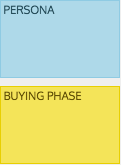
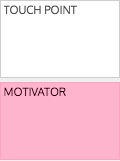
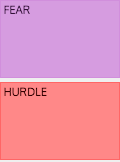
A simple legend reflecting the color-coding system
- With your legend built, create a blue card that defines your orgonza’s industry or company type. For example, “auto maintenance and repair” or “auto part manufacturer”. It’s OK to have such a broad label here, because the information you surface and document about the organization will render the specifications you need. (If you have more than one orgonza, you will want to create separate blue cards for each).

A snapshot of orgonza industries/company types
- Next, create a set of yellow cards—moving horizontally—below each orgonza. These will set the stage for the types of questions you and your team should ask yourselves to get to the heart of your orgonza’s needs and buying stages.
- For our Orgonza Story Map, we use the following yellow cards to capture these traits about an organization:
- Characteristics: What differentiates this orgonza from others?
- Risks: What risks are involved in working with this orgonza?
- Next Best Alternatives: What is the orgonza comparing your product or service to?
- Opportunity: How do you quantify/qualify the orgonza?
- Exposure: What problems motivate the orgonza to find you?
- Discovery: How does the orgonza use your product or service to solve their problem?
- Consideration: How does the orgonza decide on your product or service?
- Conversion: What outlets does the orgonza have to convert?
- Engagement: How do you close the deal?
- Delivery: How does the orgonza interact with delivery?
- Relationship: How do you keep your orgonza in the funnel?
- Advocacy: How does the orgonza share their experience?

Phases of the orgonza’s buying journey
Step 3. Document What You Know About Your Orgonzas
This is where your research or intuition will prove most useful, as you’ll be breaking down your orgonzas in depth to understand the pains of their business and build a map of empathy for your team.
- Based on the insights you’ve gathered from qualitative and quantitative research, or through brainstorming with key staff and stakeholders, add cards under each yellow card in a vertical fashion, creating white cards that explicitly define the organization’s characteristics, pain points and buying phases. You’ll want to color code these for highlighting the different points of empathy, as well.
- As you build out the organization’s features using cards, you will notice that they all start out as white. But as you create each one, you should be color coding them accordingly.
- Let’s say your orgonza is in the car maintenance and repair industry. How we would narrow in on this organization’s characteristics and buying phases is to ask ourselves some questions, like:
- What would motivate them to find a company like yours?
- What problems do they specifically face?
- What motivates them to purchase?
- What is the cost of their operations? What is their gross revenue?
- How do they decide on products or services?
- How do they learn about products or services?
- How can your product or service help grow their business? How?
- What fears do they have purchasing from a company like yours?
- What is the organization looking for in a product or service?
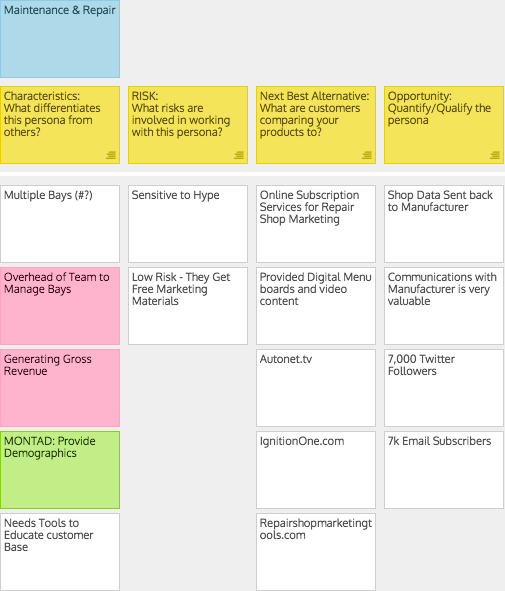
In this example, we provide a partial view of the characteristics of an orgonza
- To assist with color coding, think about the following:
- What touch points do you have with this orgonza? (white cards)
- What motivates this orgonza to move to the next buying phase? (pink cards)
- What demotivates this orgonza from moving to the next buying phase? (purple cards)
- What educational or technological hurdles do you face with this orgonza at each buying phase? (red cards)
- By answering these and other pointed questions—and color coding along the way— you should gain a comprehensive view of the orgonza’s pain points, what leads to or deters them from making purchasing decisions, and what hurdles you’ll need to help them get over with your product or service. You should be able to image the organization and their product or service needs in your mind. In this way, your sales and marketing team will you’ll know exactly how to improve their pitch, tailor messaging in a way that helps prospective organizations feel understand, and communicate why your product or service solves their pain points better than competitors.
Step 4. Present Orgonza Story Maps to Your Team
- Building Orgonza Story Maps in a silo won’t work. Your sale and marketing teams need to adopt the live documents wholly to ensure they look at the organization though the same lens and have a unified approach to the orgonza’s needs.
- Present these story maps to them and educate them on the simple concepts we have presented here. Encourage them to do a tear down and argue with what you’ve built (don’t take it personally!), and try to learn how their perspective on that orgonza informs your definition of them in that phase.
- During this phase, pay special attention to Negative Traits, which means characteristics where you say an orgonza is “NOT X”.
- This can help you to get a clear picture of what your sales and marketing team looks for in prospective organization to more easily talk with them about their needs.
Step 5. Revise Your Orgonza Story Map Based on Team/Stakeholder Feedback
- As you and your team/stakeholders discuss the Orgonza Story Map you’ve built, you might find that the perspective of the orgonza’s characteristics and buying journey has changed. If so, take the feedback you’ve all agreed upon and make revisions to the map accordingly.
- So you don’t lose the original map, we encourage you to export the Orgonza Story Map to XLS or PNG for historical records. You can achieve this by clicking the ellipsis (...) symbol and selecting “Export & Print”, then clicking “Export to PNG image file”, followed by “Export.”
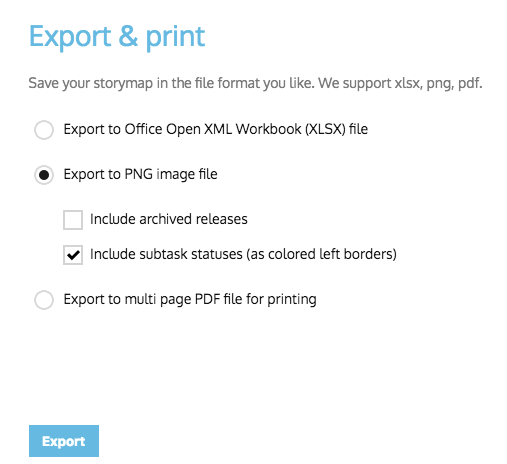
How to save a copy of your original Orgonza Story Map, before revisions are made
- While referencing the original map, you’re now free to make updates that better depicts your orgonza and their journey.
- With a finalized your map, you can now use it to fill out and plan your sales and marketing strategies.
Step 6. Schedule Orgonza Story Map Updates
No matter your business, your orgonzas will constantly evolve due to market evolution, which means your Orgonza Story Map should evolve as well.
- As you learn more about your orgonzas’ businesses—through analytics, market research, industry news, surveys and interviews, and feedback from team members who work closely with them—you will need to iteratively update this map and any other maps tied to it (e.g. digital strategy map, content strategy map, persona story map, etc). We like to make quarterly updates where we identify new opportunities with orgonzas and build marketing strategies, sales materials, and launch campaigns to help more people waste less time.

